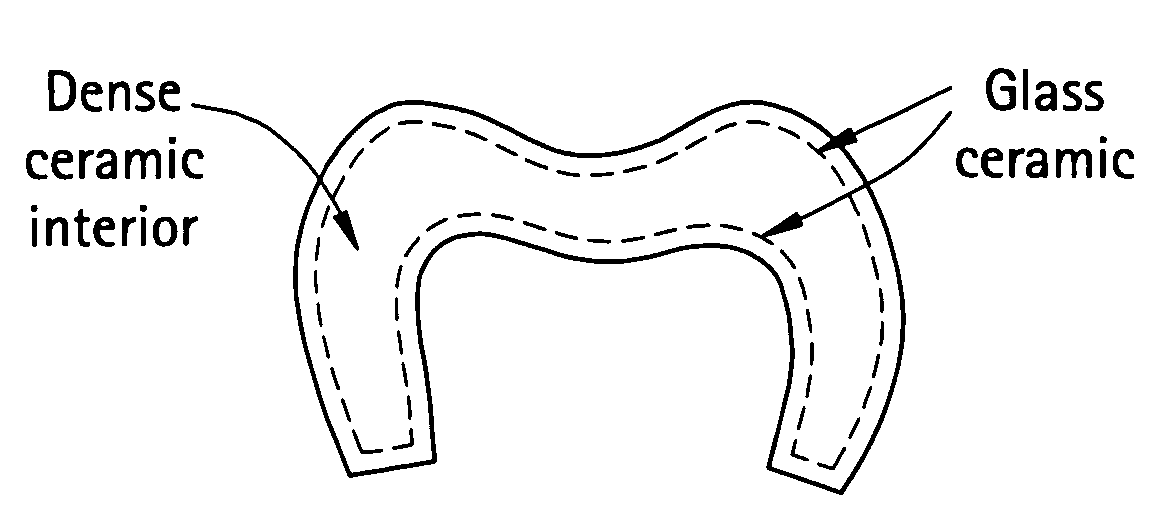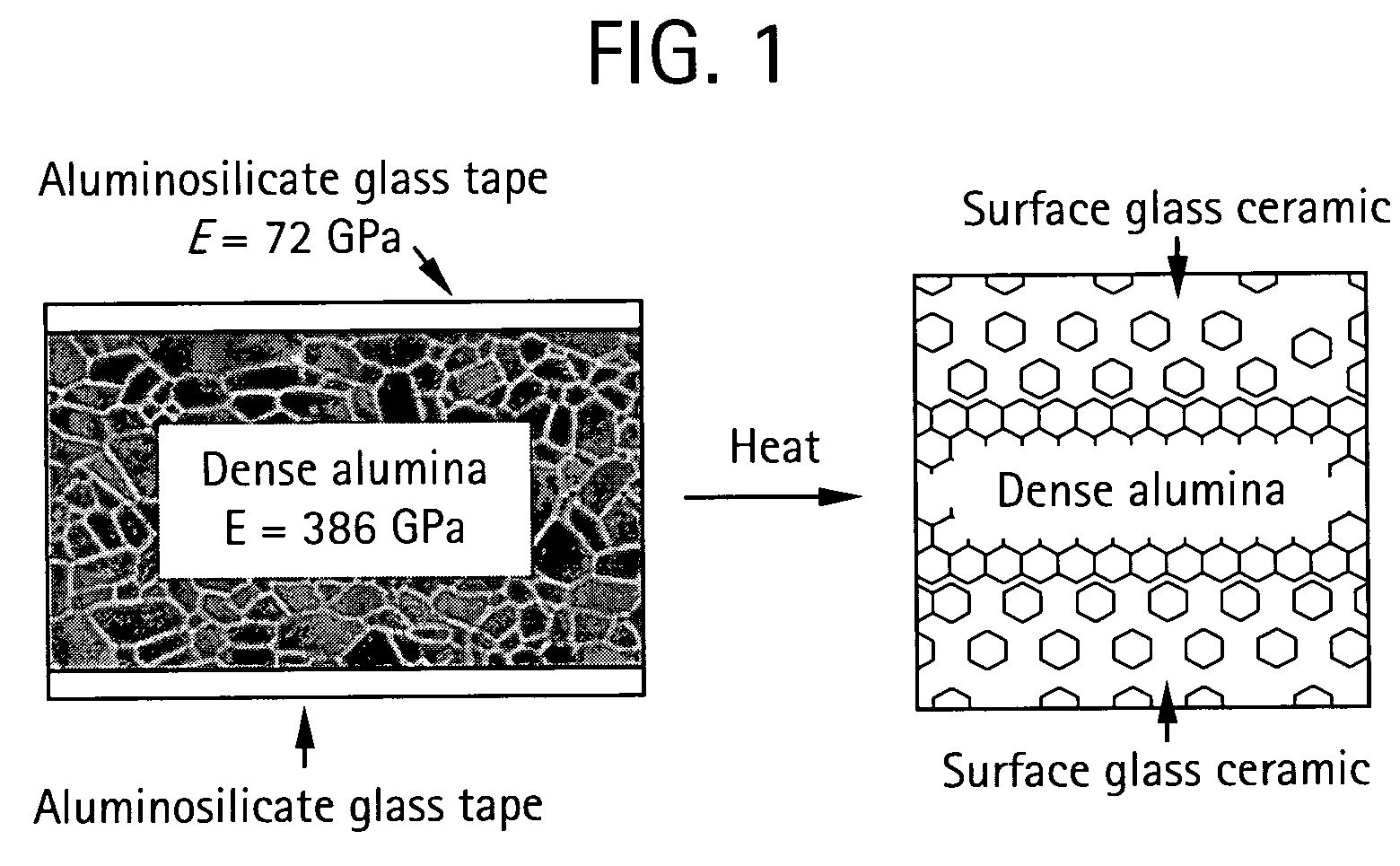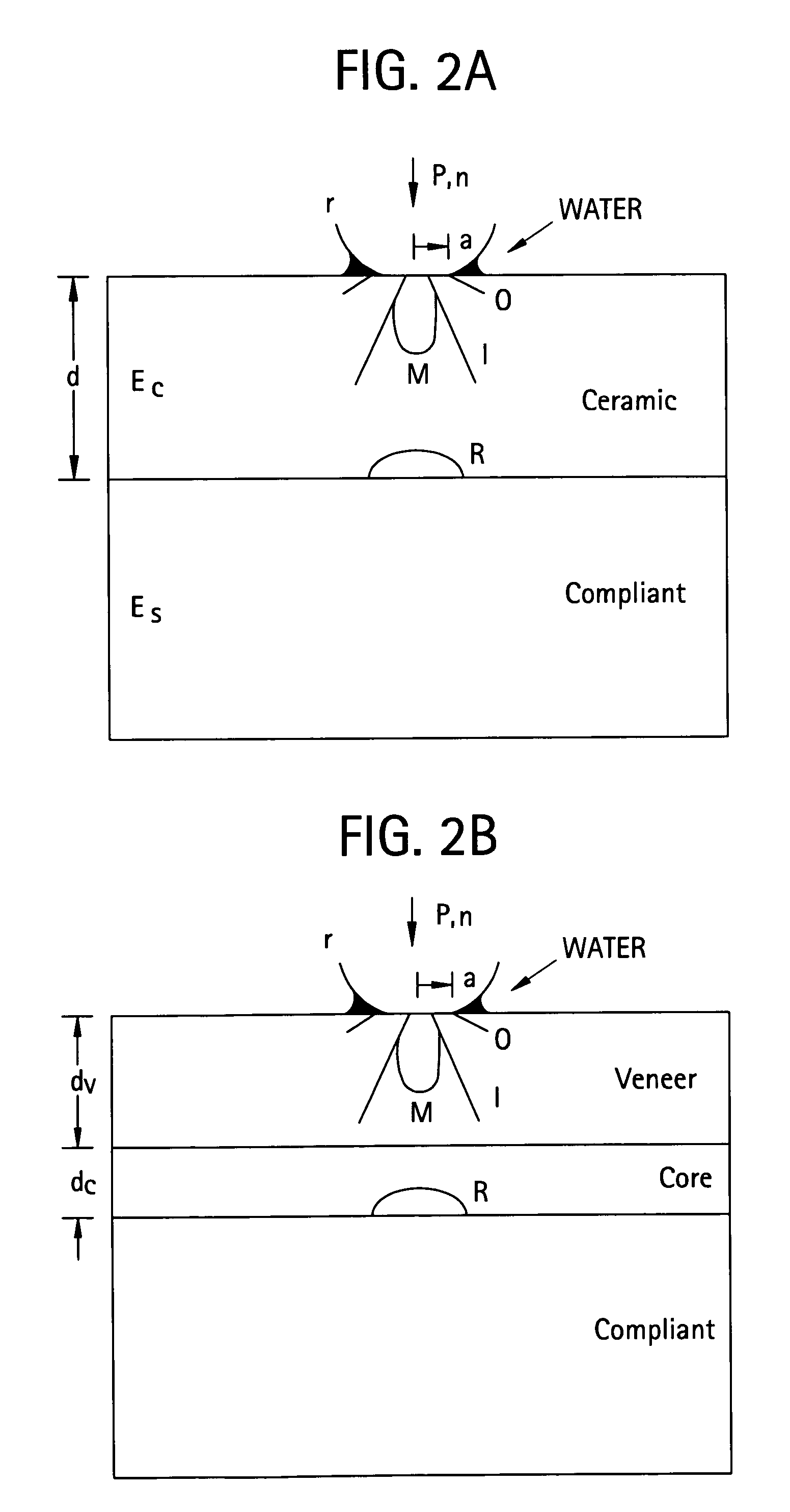Graded glass/ceramic/glass structures for damage resistant ceramic dental and orthopedic prostheses
a ceramic and dental technology, applied in the field of dental and orthopedic prostheses, can solve the problems of loss of function, loss of aesthetics, and loss of function, and achieve the effect of minimizing the fracture problem of ceramic prostheses
- Summary
- Abstract
- Description
- Claims
- Application Information
AI Technical Summary
Benefits of technology
Problems solved by technology
Method used
Image
Examples
example 1
Manufacture
[0046]Using a glass tape infiltration technique, G / A / G structures may be fabricated. Alumina discs (CoorsTek, Golden, Colo.) were polished with successive grits to 1 μm finish on both circular faces to 25 mm in diameter and 1.5 mm in thickness for glass infiltration. A commercial glass tape (G-1002, Vitta Corp. Bethel, Conn.) was evenly applied to both circular faces of each alumina disc. Glass infiltration was performed inside a high temperature box air furnace (ST-1700C-6612, Sentro Tech Corp, Berea, Ohio). Various infiltration temperatures, ranging from 1400 to 1600° C., were used to fabricate a G / A / G FGM with different glass penetration depths. A constant dwell time of 1 hour and a heating and cooling rate of 600° C. / hour were used. Thermal etching of alumina for 30 to 60 minutes at 50° C. below its sintering temperature of 1650° C. does not result in significant grain growth. This guideline was used to determine the upper limit of glass infiltration temperature.
[0047...
example 2
[0050]Materials and methods. A damage resistant G / A / G structure is fabricated using a glass-ceramic infiltration technique. Glass tape approximately 1 mm thick (CTE=7.0×10−6 m / m ° C., Vitta G-1002) is applied to both circular faces of a finely polished medical / dental grade alumina plate (φ12 mm×1.6 mm or φ12 mm×0.8 mm, CTE=7.0×10−6 m / m° C.) (Nobel Biocare, Göteborg, Sweden). Infiltration occurs inside a high temperature box air furnace (ST-1700C-6612, Sentro Tech Corp) to create a G / A / G structure (FIG. 3). A heating and cooling rate of 500° C. / hour is employed. By varying the glass infiltration temperature from 1000-1600° C., it is possible to control the glass penetration depth. The excess glass-ceramic may be ground away from both surfaces of the G / A / G structure, and the surfaces may be polished to 1 μm finish.
[0051]The microstructural gradation of the G / A / G structure may be examined using combined optical and SEM on the cross-section of the specimens. The plates may be sectioned ...
example 3
[0055]G / A / G structures of various thicknesses of graded layers at both top and bottom surfaces may be used to systematically investigate the damage response of FGMs to single- and multi-cyclic loadings using spherical indenters with and without a sliding component, aiming to establish the structure-property relation of FGMs. This is based upon previous studies in which an alumina plate (4 mm thick) with one of its surfaces graded with aluminosilicate glass (2 mm thick) exhibited improved resistance to contact damage from normal single cycle loading at 3000 N, as well as from single path sliding at 800 N, relative to both bulk alumina and aluminosilicate glass. There is an optimized thickness of the surface graded layers that results in a best combination of resistance to contact, sliding, and flexural damage.
[0056]Materials and methods. A G / A / G structure with two final dimensions may be fabricated: φ12 mm×1.6 mm or φ12 mm×0.8 mm. Three groups of specimens with different graded glass...
PUM
| Property | Measurement | Unit |
|---|---|---|
| Temperature | aaaaa | aaaaa |
| Temperature | aaaaa | aaaaa |
| Temperature | aaaaa | aaaaa |
Abstract
Description
Claims
Application Information
 Login to View More
Login to View More - R&D
- Intellectual Property
- Life Sciences
- Materials
- Tech Scout
- Unparalleled Data Quality
- Higher Quality Content
- 60% Fewer Hallucinations
Browse by: Latest US Patents, China's latest patents, Technical Efficacy Thesaurus, Application Domain, Technology Topic, Popular Technical Reports.
© 2025 PatSnap. All rights reserved.Legal|Privacy policy|Modern Slavery Act Transparency Statement|Sitemap|About US| Contact US: help@patsnap.com



